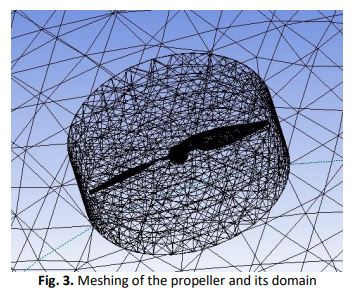CFD Analysis on Propeller at Varying Propeller Disc Angle and Advance Ratio
DOI:
https://doi.org/10.37934/arfmts.96.1.8295Keywords:
Non-zero propeller disc angle, APC propeller, ANSYS FLUENT, SST k-ω model, multiple reference frame (MRF)Abstract
The purpose of this study is to see the feasibility of using Computational Fluid Dynamic (CFD) analysis over wind tunnel testing for propeller performance measurement. Computational Fluid Dynamic (CFD) analysis is conducted on APC 6X4E propeller and 9X6E propeller at propeller disc angle, α of 0°, 30°, 60°, and 90° using commercially available software ANSYS FLUENT at advance ratio ranging from 0 to 0.88 and angular velocity ranging from 1000rpm to 8000rpm. CFD analysis was also performed for different advance ratio at different rotational speed of 4000rpm and 8000rpm. Multiple Reference Frame model is used to simulate the rotating propeller in a flowing airstream by constructing a rotating and static domain around the propeller. The non-zero propeller disc angle is achieved by changing the inlet direction of the static domain. The SST k-ω turbulence model is used, and tetrahedral mesh is constructed. The propeller thrust and torque obtained from the CFD simulation is used to calculate the aerodynamic characteristics of the propellers. The thrust coefficient, torque coefficient and propeller efficiency obtained for both propellers follow the trend of the wind tunnel testing. The results obtained from the CFD simulation matches with the results trend obtained by another researcher performing wind tunnel analysis, where the thrust coefficient decreases with increasing advance ratio at propeller disc angle less than 60° and increases with increasing advance ratio at propeller disc angle more than 70°. The error produce for thrust estimation is lower than 12% for both 6x4E and 9x6E propellers. The error for torque and efficiency estimation is between 15-30% and 12% respectively. In conclusion, CFD simulation can predict the aerodynamic characteristics of Low Reynolds Number propeller at different propeller disc angle.
Downloads






























